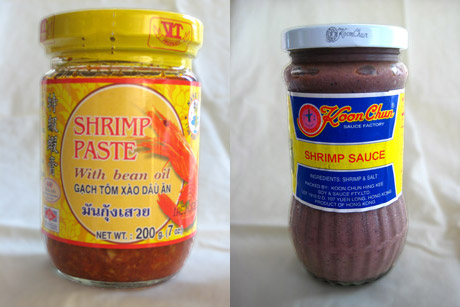My friend Serene posted a mouthwatering photo of Thai Noodle Soup and it looked so good I had to try the recipe myself. It calls for Thai shrimp paste (belachan), which meant a trip to one of San Diego’s many Asian grocers.
We discovered something that’s not clear from the Wikipedia article or most of the other references we found online: there are 2 very different things available called “shrimp paste.”

Our first stop was a Vietnamese store, and the only thing we could find were several brands of the stuff on the left: shrimp paste in soybean oil, whose ingredients include shrimp, garlic, soybean oil, pepper, salt, paprika, and often MSG. However, from what I’d seen online, that didn’t seem right. It smells shrimpy, but it wasn’t the “light pinkish gray” or dark brown block that I was expecting. So then we stopped at a Korean store, and picked up the jar on the right. Ingredients: shrimp and salt. Light pinkish gray. Smells like death. But called “shrimp sauce.”
We made the soup with the stuff on the right. It was great (thanks Serene!). Like fish sauce, it adds a wonderful earthy richness when it’s cooked in the soup. The other stuff seems a bit more like a condiment or stir-fry sauce – it’s still got a strong shrimpy aroma, but nothing like the gut-wrenching power of plain shrimp paste (the recipe calls for “a pea-sized piece”).
hey Matt, the shrimp paste, or belachan, that you are looking for looks like this:
http://www.asiacurry.com/upload/data/item_55649403DSC01728.JPG
It tends to come in a dry hard block that brown in color (once you remove the packaging). When dried and cut up, it looks like the brown blocks on the picture in this wikipedia entry:
http://en.wikipedia.org/wiki/Shrimp_paste
From what I can tell (from Wikipedia and other sites), the dried block and the “shrimp sauce” on the right are pretty much the same stuff, with the difference that the block is sun-dried before packaging. Results in a slightly different flavor, but in the same ballpark. We couldn’t find any of the blocks at the two stores we tried.
Shrimp paste comes in block form and it’s a dark (almost black) color, and very “stinky”.
To make shrimp paste now, only tiny plankton shrimp are used, and the process starts when the shrimp are freshly caught. The shrimp are mixed with salt, put in a tank and left to sit for 2 days. Then the mixture is put under sunlight for a day or two, pounded up and pulverized, and put back in a tank to ferment for 6 months. Here is a link to shrimp paste info & photos as well.
How Shrimp Paste is Made